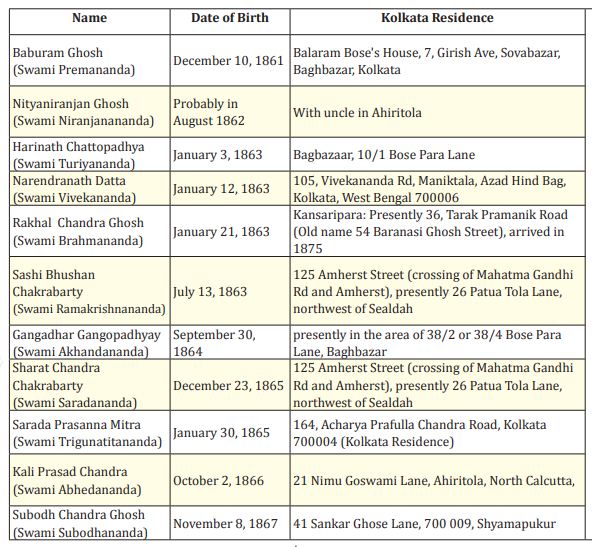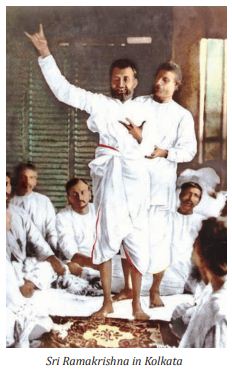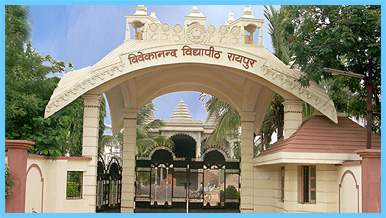Between 1881 and 1886 — the last five years of Sri Ramakrishna’s sojourn on earth —
twelve of the sixteen direct disciples of Sri Ramakrishna lived in North Kolkata. They were either
born there or had moved there for education or work. In hindsight we can see the Divine Mother’s
plan in placing these young men in this region of Kolkata, thus making it possible for them to
frequently meet Sri Ramakrishna and come under his life-transforming influence. The author
narrates this fascinating story in this and three subsequent articles.
When he was suffering from throat cancer, Sri Ramakrishna once told his householder devotee Mahendranath Gupta, “This illness is showing who belong to the inner circle and who to the outer. Those who are living here, renouncing the world, belong to the inner circle; and those who pay occasional visits and ask, ‘How are you, sir?’ belong to the outer circle. … When God assumes a human body for the sake of His devotees, many of His devotees accompany Him to this earth. Some of them belong to the inner circle, some to the outer circle, and some become the suppliers of His physical needs.”1
This article discusses three things: 1) the spiritual power of an incarnation’s inner circle and how visiting their homes benefits spiritual aspirants; 2) why Sri Ramakrishna visited Balaram Bose’s house in Northern Kolkata more than one hundred times in his final years (1881-86); 3) rare research findings of the homes and addresses of twelve of Sri Ramakrishna’s monastic disciples in Northern Kolkata.
Spiritual power of an Incarnation’s inner circle
Why is it necessary to know where the monastic disciples of an incarnation lived? The answer is: ‘power of association’. Learning about the places which an incarnation visited helps us to purify our minds and to make spiritual progress. One of the spiritual practices of Mahendranath Gupta (hereafter Sri M.), the chronicler of the Kathamrita or The Gospel of Sri Ramakrishna, was to bow down to holy places whenever he passed by them. Every day, on his way to his school, he would bow down at the place on Bechu Chatterjee Street where Sri Ramakrishna’s elder brother once conducted a Sanskrit Tolle. He would also bow down to the house of the Mitra family at Jhamapukur, where Sri Ramakrishna once officiated as a priest. Observing his companions’ surprise, M., would tell them, “Do you know that anyone who walks through this street will become a yogi?”2
In other words, places associated with Sri Ramakrishna’s direct disciples become sacred places for spiritual seekers. Each of these monastic disciples was a spiritual giant whose spiritual powers were largely overshadowed by the glory and spiritual brilliance of Sri Ramakrishna, Holy Mother Sri Sarada Devi, and Swami Vivekananda.

In the Gospel, Sri Ramakrishna often tells the parable of the eggplant seller who offers only nine seers of eggplant for an expensive jewel. The lesson is that only a master jeweller can understand the true value of an expensive jewel.
Likewise, Swami Vivekananda, a master jeweller of the spiritual realm, gives us the true spiritual estimate of his monastic brother disciples. In Talks with Swami Vivekananda, Sarat Chandra quotes Swamiji: “Sri Ramakrishna was a wonderful gardener. Therefore, he has made a bouquet of different flowers and formed his Order… Know each of those who are here to be of great spiritual power. Because they remain shrivelled before me, do not think them to be ordinary souls. When they will go out they will be the cause of the awakening of spirituality in people. Know them to be part of the spiritual body of Sri Ramakrishna, who was the embodiment of infinite religious ideas. I look upon them with that eye. See, for instance, Brahmananda, who is here—even I do not have the spirituality which he has. Sri Ramakrishna looked upon him as his spiritual son and he lived and walked, ate and slept with him. He is the ornament of our Math, our king. Similarly, Premananda, Turiyananda, Trigunatita, Akhandananda, Saradananda, Ramakrishanananda, Subodhananda and others—you may go round the world, but it is doubtful if you will find men of such spirituality and faith in God like them. They are each a centre of religious power and in time that power will manifest.”3
Five stages of an Incarnation’s life
The life and work of an incarnation unfolds in five stages. In the first stage, the incarnation lives like an ordinary individual but quickly experiences dissatisfaction with the world. In the second stage, the incarnation engages in intense spiritual practices. In the third stage, he attains spiritual perfection and then begins to help other suffering souls. In the fourth stage, sensing his impending departure from this physical world, he begins to gather his disciples, to whom he can impart the fruits of his spiritual realisations, and who can later spread his teachings to the world. We see this clearly in the lives of Bhagawan Buddha, Jesus Christ, and Sri Chaitanya Dev. After his enlightenment, Buddha gathered ten principal disciples around him in Sarnath. Similarly, towards the end of his life, Jesus gathered twelve apostles. Finally, Sri Chaitanya Dev gathered six main disciples. And in the case of Sri Ramakrishna, he gathered sixteen monastic disciples around him. In the fifth and final stage, the incarnation leaves his body in the state of mahasamadhi.

In the fourth stage of Sri Ramakrishna’s life, he brought his young monastic disciples together during the last five years of his life (1881-86). Much before this, as he later explained, he would go to the roof of the Kuthi in Dakshineswar Temple garden, look towards Northern Kolkata, and cry out in his native Bengali “ore tora ke kothay aachis aay”4 , “Oh, where are you all? Come to me!” Yet for many years they did not come! So why did Sri Ramakrishna look towards Northern Kolkata?

Amazingly, six of his monastic disciples were born in Northern Kolkata: Narendranath Datta in Simla, Subodh Chandra Ghosh in Shyamabazaar, Sarat Chandra Chakrabarty in Northern/ Central Kolkata, Harinath Chattopadhya in Baghbazar, Gangadhar Gangopadhyay in Ahiritola and later shifted to Baghbazar, and Kali Prasad Chandra in Ahiritola. The other six disciples would move from their villages to Northern Kolkata for further education or work. They were Rakhal Chandra Ghosh to Simla, Shashi Bhushan Chakrabarty to Northern Central Kolkata, Sarada Prasanna Mitra to Shyamabazar, Baburam Ghosh to Ahiritola and then Baghbazar, Nityaniranjan Ghosh to Ahiritola. Finally, Taraknath Ghosal (Swami Shivananda), who was nearly ten years older than his other brother disciples, would stay in Northern Kolkata during the week in connection with his work, and would return to his village in Barasat during the weekend.
Why North Kolkata?
During this period, Kolkata was the capital of India. And North Kolkata in particular, was the administrative centre and a cultural, economic, educational, literary, philosophical, and spiritual hub. This provided great scope for young people to develop their personality. A classic example of this is Kali Prasad Chandra who later became Swami Abhedananda. As a young boy, he received a traditional Sanskrit education and was interested in Indian philosophy. As a teenager, he attended the lectures of the great national leader Surendranath Banerjee, the famous Brahmo leaders Keshab Chandra Sen and Pratap Chandra Majumdar, and the Christian evangelist Reverend Kali Charan Banerjee. In 1882-83 Pandit Sashadhar Tarkachudamani, a well-known scholar, began to interpret Hinduism from the scientific point of view and gave a series of lectures on the six systems of Hindu philosophy. Kali regularly attended these lectures in Albert Hall. Furthermore, he learned Patanjali’s Yoga Sutras from Kalibar Vedantavagish.5 Thus those who grew up in Northern Kolkata during this time had the rare opportunity to study and understand Indian philosophy from various angles. This constant search for higher thoughts left many of them dissatisfied with mere scholarship and they sought a spiritual teacher who had realised the truths spoken of in the scriptures.
North Kolkata’s advantage
The young disciples were teenagers living under parental restrictions and studying in secondary school or college. As Dakshineswar is about 13 kilometers away from North Kolkata, they could not make a quick visit to Dakshineswar unnoticed by their parents. Hence, they would visit mainly on weekends, often avoiding the notice of their parents or guardians. Furthermore, the young disciples did not have the money for round trip fare by carriage or boat.
The solution
Since he wanted his young disciples to visit him frequently, Sri Ramakrishna often made arrangements for their visit to Dakshineswar. But he needed a place in Kolkata where he could meet and interact with them freely. This he found in the house of his dear householder devotee Balaram Bose in Baghbazar. He called this home his baithak-khana or Parlour room. Eventually, in the last five years of his life, Sri Ramakrishna visited this house over 100 times! Balaram’s house became the central meeting place for devotees. Sri M. writes, “And so it happened that whenever the Master was at Balaram’s house, the devotees would gather there. It was the Master’s chief vineyard in Calcutta. It was here that the devotees came to know each other intimately.”6
Years later, Swami Premananda nicely expressed the love that Sri Ramakrishna bestowed on his future monastic disciples: “Oh, how can I explain to you how much he loved us! He would go to Calcutta in a carriage just so he could feed Purna. He would wait near the school where Purna went, send someone to bring the boy, then feed him delicacies…One day he was found waiting outside Balaram Babu’s house where I was staying. Balaram Babu was not at home, and the Master was hesitant to go inside, thinking he might not be welcomed. He had come to see me. Someone finally called him in. His love knew no bounds, and one drop of it completely filled us. Each one thus thought himself to be the most beloved of the Master.”7
The homes of the direct disciples, both monastic and lay, which Sri Ramakrishna visited are sacred spaces. Fortunately, many of these homes are still in existence. In these upcoming issues, we will explore these holy homes of both his monastic and lay disciples in the areas of Baghbazar, Shyambazar, and Simla.*
References
1) The Gospel of Sri Ramakrishna [hereafter Gospel]. p. 933
2) They Lived with God. p.221
3) Talks with Swami Vivekananda. p. 392-93
4) Kathamrita, p. 1103, Gospel. p. 832, August 9, 1885.
5) They Lived with God. p. 443
6) Gospel. p. 724
7) They Lived with God. p. 184
Source : Vedanta Kesari, August, 2021

